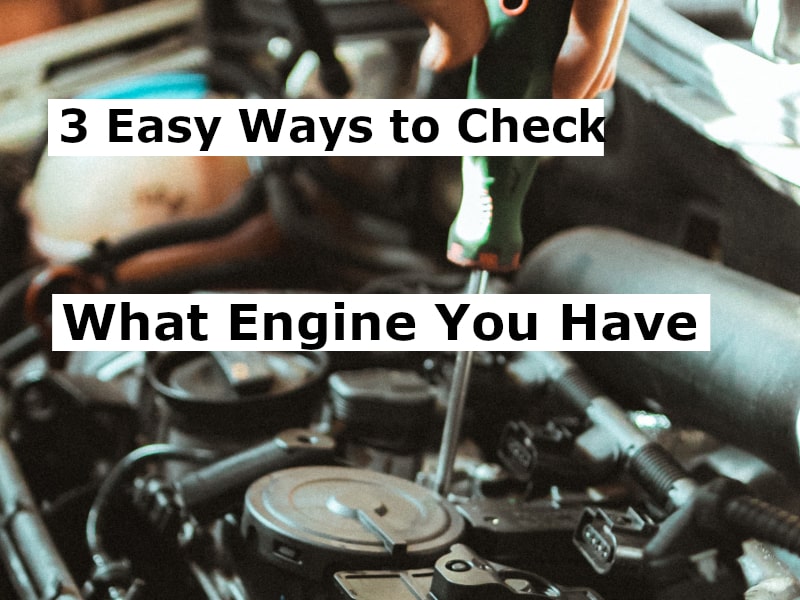If you do not know what engine your car is equipped with then you may face problems in the future when doing some repairs or purchasing other mechanical parts which are linked to your engine.
In this guide, I will explain simply three simple ways to check what engine your car has.
1. Using Google or any Search Engine
This is a simple and straightforward method that only requires some observation and a phone with internet connectivity.
If you already know about your car’s model and make, simply google the name of the with the keyword “engine” and you will find the official website of the automaker with all the details about the car’s engine.
If you are buying a used vehicle and would like to know the engine then simply ask the owner for the car model and make or check for badges at the back of the vehicle. After that simply google the name and model of the car and a google search will tell you about the engine specifications.
Also read: Are EcoBoost Engines Good? (+ Problems They Have)
2. Checking Owner’s Manual or Asking the Automaker Directly
You can also check your car’s owner manual to know all about the type of engine the car has and also other important mechanical information. If you have lost your owner’s manual, simply call any official dealer of the automaker and inquire from them.
Another good idea would be to visit an official dealer near you and have a professional inspect your vehicle who can guide you more about your car’s engine type and other details.
Read it: 10 Car Brands that Rust the Most (Don’t Buy Them)
3. Look up Vehicle Specification by VIN
This is perhaps the best way to find out your car’s engine type and also know other useful details about the mechanics. For this, you need to know something called “VIN” or a vehicle identification number which includes within it some specific details about your car.
What is VIN – Vehicle Identification Number?
VIN or vehicle identification number is a unique 17 digit code that includes both numbers and alphabets and it carries details about your car such as engine type and more.
The VIN number is unique to each vehicle and it consists of three specific parts. The first three digits are the world manufacturer identifier (WMI) which tell who the automaker is. The next six digits denote the vehicle descriptor section or VDS and this is used to identify the vehicle type, body style, and platform used.
The last eight digits are the vehicle identifier section or VIS and they carry details about the vehicle’s model year, where it was built and information about engine and transmission.
Trending Video: How to Easily Bring Back to Life any Old Car Battery and Save Tons of Money (click to watch)
To know about the engine in your car through the VIN number, follow these steps.
Step 1: Locate the VIN on Your Vehicle
There are a number of locations where VIN is usually found such as beneath the windscreen on the driver’s side, on the driver’s side door frame, or on the metal plate under the hood.
If you do not find the VIN on any of those places then you can also check on the chassis by going underneath the car.
Step 2: Note down the Code
Once you find the number, note down the 17-digit code as it is. Any error within the code or an incorrect digit will create problems when decoding it.
Step 3: Decode the VIN
Once you have the VIN code, it is now time to decode it and get to know more about your car’s engine. Luckily, there are a number of websites available now which allow you to simply put in the VIN and get the information for free.
Websites such as www.vincheck.info can provide you information about your car for free while some may charge additional money to get a more detailed report.
Decoding the VIN code will tell you about the engine size and other vital information.
When is a VIN Required?
The VIN code may be required when you buy a used car, looking for parts for your vehicle or if you are just interested in knowing more specifications about your car’s engine.
When buying a used car, it is recommended that you obtain the VIN code from the buyer and decode it to know the history of the vehicle’s engine whether it is repaired, and more.
Also read: 2.0 EcoBoost vs 2.5 Hybrid- Which Engine is Better
What are Different Types of Engines?
Before discussing how to check what engine you have, let us first have a look at different engine types that exist.
Twin-cylinder engine: Twin-cylinder engines are rarely found in cars now as they are low in power. However, some small cars such as the Fiat 500 is equipped with such engine.
Three-cylinder engine: The three-cylinder engine is mostly found in smaller cars but It can be paired with a turbocharger and installed on larger vehicles as well. Some popular cars with a three-cylinder engine include Ford Fiesta, Ford Focus, and the Mini Cooper.
Four-cylinder engine: These types of engines are most frequently used in both small to midsize cars and even some large vehicles. Some vehicles such as Subaru WRX, Audi S3, Honda Civic, BMW 3-Series are all equipped with a four-cylinder engine paired with a turbocharger.
Five-cylinder engine: Five-cylinder engines are usually found in Volvo vehicles and they are popular for their compact size similar to a four-cylinder unit.
Six-and-eight-cylinder engine: Most high-performance and sports cars are equipped with either a six-cylinder or an eight-cylinder engine.
Now that you have some general knowledge about the car’s engine and cylinders let’s discuss how we can check what engine your car has.

